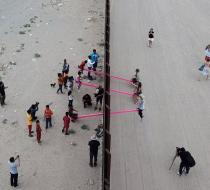Teeter-Totter Wall Favorite
An installation by architecture studio Rael San Fratello, which connected children in the US and Mexico via a trio of seesaws slotted into the countries' border wall, has been crowned the Design of the Year.
Dubbed the Teeter-Totter Wall, the project was in place for only around 40 minutes in July of 2019 and hoped to foster a sense of unity at the divisive border, which was highly politicised under the Trump administration.
Today, the seesaws devised by architects Virginia San Fratello and Ronald Rael were named both the transport category winner as well as the overall winner of the Beazley Designs of the Year awards, which are organised by London's Design Museum every year. A five-person jury, which included designer Camille Walala and Ma-tt-er founder Seetal Solanki, came to its decision in the immediate aftermath of Joe Biden's victory in the US presidential election.
Now, the result is being announced just a day before his inauguration and Donald Trump's departure from office. In light of these events, Rael San Fratello's project once again takes on a particular significance, with the Design Museum's chief executive and director Tim Marlow describing it as an "inventive and poignant reminder of how human beings can transcend the forces that seek to divide us.""It's become increasingly clear that walls don't work," San Fratello added. "Walls did not keep the violent protestors out of our government buildings and they have not kept Covid out of our country. We should be building bridges, not walls."
"We are living in a time when people are longing for meaningful connections and we would like to think the teeter-totter can be an example for how we come together, to create balance and equality," she told Dezeen.
"Play can be an act of resistance"
Rael San Fratello worked with Mexico's Colectivo Chopeke to smuggle the seesaws into place, with one team coming from each side of the border to help slide the boards in between the tall, metal slats that divide El Paso in Texas from the Mexican city of Ciudad Juárez. In a live interview as part of Dezeen's Virtual Design Festival last year, San Fratello revealed that the "guerilla project" never received official permission and was designed to be assembled as quickly and covertly as possible in case border patrol were to intervene.
Jennifer Hahn | 19 January 2021 | dezeen







